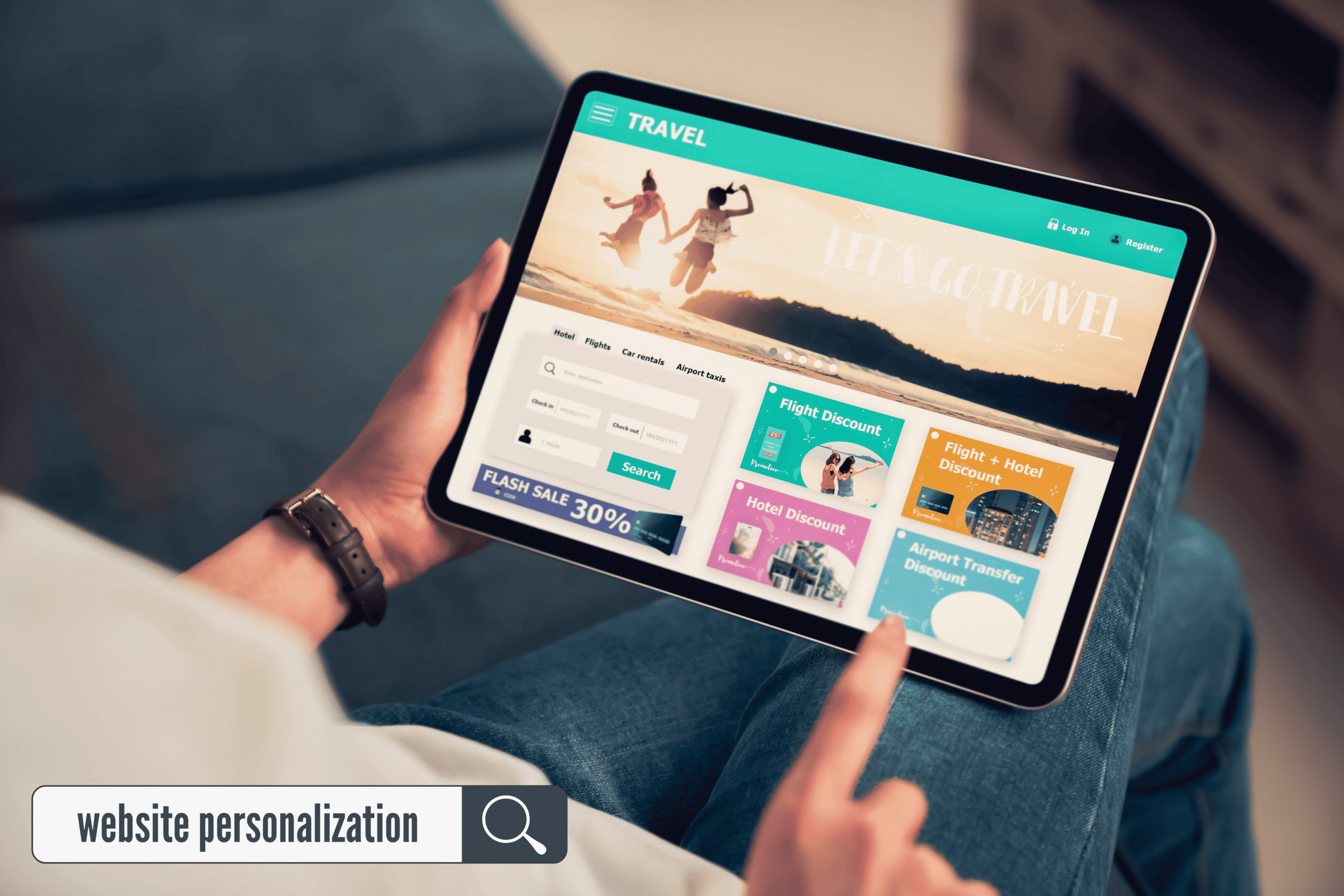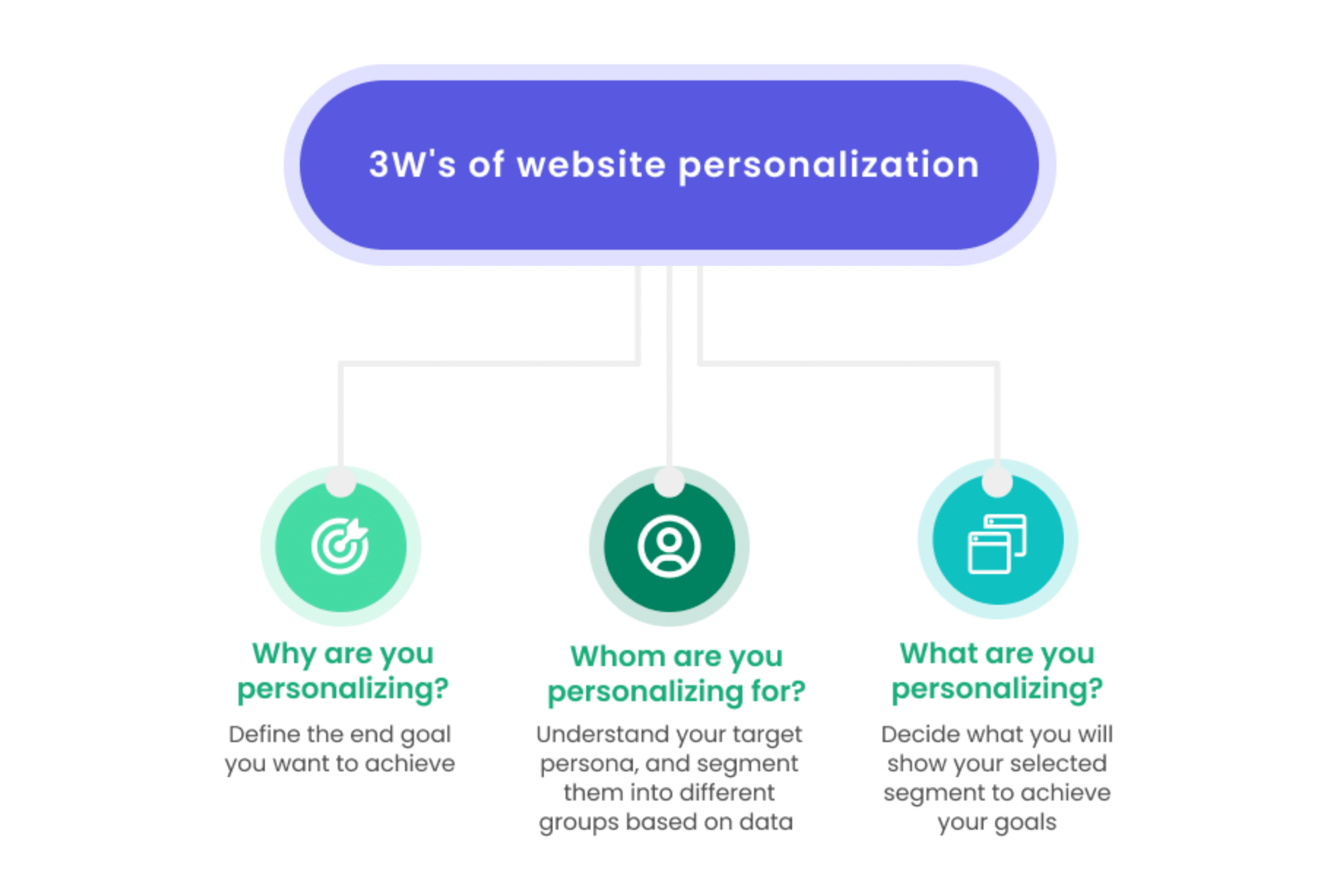When it comes to personalization, there's no one-size-fits-all approach. You have to know what your users want and why they want it, then you can give them what they need. Personalization is the key to making your website more engaging and effective. With personalization, you can tailor your website to your audience's needs, which makes it easier for them to find what they're looking for and helps them feel like the website is designed just for them.
An online store with personalized recommendations is more likely to attract 45% of shoppers (According to research).
But what does all this mean? How do you go about implementing personalization on your website? And how do you know if you're doing it right? We'll show you examples from some of the biggest and most successful companies around, so that you can see how they use this important tool in their marketing strategy.
What is Website Personalization?

Website personalization is the process of tailoring a website to meet the needs of specific visitors. It involves using data to determine which content, products or services are most relevant to each individual visitor. The goal is to deliver a more personalized experience that keeps customers coming back for more.
Personalization can be used across all aspects of a website, from search engine optimization (SEO) and content creation, to marketing and customer service. Website personalization can include many different elements such as:
This includes:
Why Does Website Personalization Matter?
Personalization is the process of customizing content and communications to each individual visitor. It’s a way of making your website or app feel more like home, and it has been proven to increase engagement and conversion rates. Here are a few good reasons why you should personalize your website:
The Benefits of Website Personalization
Here are five reasons why you should consider adding personalized elements to your website:
1. Improved User Experience
A personalized website is more likely to keep users engaged with your content and allow them to find what they need quickly. By tailoring the content of your website around the needs of each individual visitor, you can improve their experience on your site and encourage them to return again in the future. This can boost conversions, as customers who feel valued are more likely to purchase from you.
2. Increased Engagement
One of the most important benefits of website personalization is increased engagement. When visitors feel that they're receiving relevant information, they're more likely to spend time on your site and interact with it. This can mean reading articles or watching videos, but it also means that they'll spend more time browsing through product pages or reading reviews before making a purchase decision. If you have an ecommerce store, this could translate into higher sales numbers as well.
As we’ve seen, people like to feel special and unique. When you provide them with something that is relevant to their needs or interests, they are more likely to engage with your content and stay on your site for longer. This can lead to higher sales and better search engine rankings.
According to a report, personalized emails have an open rate of 20 percent compared to regular emails that only receive an 11 percent open rate. The same goes for websites, personalized sites are more likely to get more visitors and generate more leads than non-personalized ones. (Related: 6 Email Marketing Automation Best Practices That Will Boost Revenue (with Examples))
3. Better Conversion Rates
Personalizing a website can help you increase conversion rates by showing visitors exactly what they want when they want it.
For example, if someone has visited before but not yet purchased anything, you could show them offers that might interest them more than others would – such as “5 reasons why I love my new dog” or “10 reasons why we should work out together”. You could also ensure that any relevant blog posts or videos are displayed prominently on the homepage for returning visitors who may have missed them previously.
4. Reduced Bounce Rate
Personalization is one of the most effective ways to reduce bounce rates. It involves using data about your visitors to customize their experience on your website. With personalization, you can show each visitor exactly what they want to see and encourage them to stay longer on your site. The more personalized your website is, the more likely a visitor will be to stay on the page. This is especially true for high-value pages like the homepage or landing pages.
A study by Adobe found that personalized web pages can increase conversion rates up to 68%. Here are some examples of personalized websites:
5. More Targeted Advertising
Personalization allows you to target specific visitors with ads that are relevant to them. This means you can show them products they're more likely to buy, which will increase the likelihood of a sale. Plus, it's more pleasant for the visitor to be shown something they're interested in rather than random ads they don't care about.
Visitors want to see content that's relevant to them — it's why they visit your website in the first place! Personalization helps ensure that your content is relevant to each visitor and shows them what they want to see. If you know what kind of content different groups of people want to see on your site (e.g., customers vs potential customers), then you can customize it accordingly.
6. More Relevant Products
Personalization is great for eCommerce businesses because it creates a shopping experience that's tailored to your customers. You can recommend products based on previous purchases or search history, which means customers are more likely to buy something they're interested in buying. In addition, you can also recommend products that complement the items they currently have in their cart, which will help increase the average order value of each customer.
7. Improved SEO
Personalized content helps your website rank higher on search engine results pages (SERPs). This is because Google looks at the personalization information on your website and uses that information when determining how relevant your content is compared to similar content published on other websites.
For example, if you write an article about "how to cook spaghetti" and include some personalization data that identifies this as an article about cooking spaghetti for a particular user (for example: "how to cook spaghetti for Jane Smith"), then Google will consider this page more relevant than another page that contains the same title but no personalization data.
8. It is Easier than Ever Before
As customers, we're all a little picky when it comes to what we want from a website. We want it to be fast, easy to use and reflect our brand and style. But, most importantly, we want it to be personalized.
It's easier than ever before for websites to adapt and change based on the user's preferences and behaviors. Personalization is no longer just a nice-to-have — it's an essential part of the customer experience. Here are five reasons why: customers who feel like they've been given exactly what they want will be more likely to convert than those who aren't.
According to research by MarketingSherpa, personalized content increased conversion rates by nearly 50 percent in B2B marketing campaigns compared with non-personalized content.
How to Personalize Your Website

(Source: Mailmodo)
The idea of personalization has been around for years, but it's only recently that companies have started to put it into practice. The idea is simple: by tailoring an experience to each customer's needs, you can make them more likely to buy from you and stay loyal to your brand. (Related: Five Levels of Customer Awareness and How to Effectively Market to Each Level)
"The more personal we can make the experience." says Paul Dunay, a senior vice president at Salesforce.com, "the more likely they are to come back."
Buyer Personas
Buyer personas are a fictitious representation of your ideal customer. They're based on real information about your industry, the kinds of people who buy from you, and what they want to achieve with your product or service.
When you create buyer personas, you can start to see patterns within your audience. You'll see what they're interested in, how they behave online, and what makes them different from other people who also use your product or service. This is important because it helps you understand what makes each customer unique. If you know that one customer loves video tutorials but another prefers written guides, then you can create content that speaks to both audiences by providing both formats.
Geolocation
Geolocation is the practice of identifying the real-world geographic location of a person, place, or thing. It's the process of determining a user's location based on their IP address. There are a number of ways to do this, but most geolocation services use one or more of the following methods:
Device Type
The first step to personalizing your website is to make sure that it is designed for a specific device type. The most common device types are mobile, tablet, and desktop. You should also consider whether or not you want your website to be accessible on TV screens and other large displays.
When designing your website’s layout, you should keep in mind how visitors use different devices to view your site. Visitors who browse with their mobile phones may not have the same expectations as those who use their desktop computers or tablets. Mobile visitors expect websites to load quickly and look good on small screens. They also want to be able to easily enter information into forms, so they can complete purchases or sign up for accounts.
Tablet owners generally have larger screens than mobile users, but they still expect websites that work well on their devices. They also expect sites to load quickly and be easy to navigate with touch controls instead of keyboards or mice. Desktop users typically have large screens, which means they can see more of your content at once and read longer blocks of text without scrolling up or down too often.
Time Spent on Page
This is one of the most basic ways to personalize a website and it’s also one of the easiest to implement. By tracking how long visitors spend on each page, you can determine which pages are performing well, and which ones need more attention. You can then use this information when deciding what content should be promoted in your navigation bar or sidebar. It's important to understand the psychology behind the way people search for products and services.
Take a look at the following search results for the keyword "personal trainer". If you're a personal trainer, you know that this is a competitive market with a lot of different businesses. But what if I told you that most people only spend about 20 seconds on this page before moving on?
This means that you have about 20 seconds to convince them that your business is worthy of their time.
Browser Information
Another common way to personalize a website is by tracking information about a visitor’s browser. This includes things like their operating system and browser version, but also more advanced information like whether they have an ad blocker installed or not. If you know that someone has an ad blocker installed, you might want to create an ad experience that doesn’t require them to disable their ad blocker before viewing it.
Final Thoughts
There are many ways to personalize a website. Whether the site is a blog, or storefront, it is important to remember that visitors come to the site because they are looking for something. Whether they are looking for information on a product or service offered by your company or just there out of idle curiosity, personalization will be able to draw them in better than a cookie cutter site ever will.
